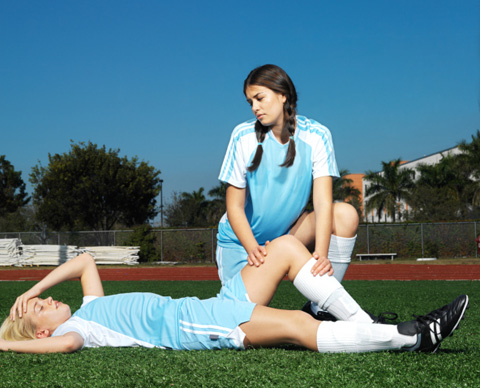Cooler weather means fall sports are in full swing. While many children can hardly wait to get on the field and begin competing, many parents have the worry in the back of their minds: What happens if my child gets hurt?

This is a very real concern that affects millions of children around the nation each year. We have seen an uptick in sports-related injuries because students simply have more athletic opportunities available to them. Children’s gyms and a larger variety of sports now allow almost any interested child to participate in a sport. This, paired with an increased pressure to someday land an athletic scholarship, accounts for the rise we’re seeing in sports injuries.
However, a little awareness and some preventative measures go a long way. Below is a guide to some of the most popular sports this season, the most common sprains and strains for each, and how to up your chances of staying injury-free.
Football
Football tends to be one of the highest impact sports, even if it’s played flag or touch style. The fast speed, high energy and potential for collisions are all contributors to the most common injuries from playing football. These include concussions and head injuries, muscles strains, sprains and broken bones.
Volleyball
Most of the injuries sustained while playing volleyball comes from diving for the ball. This can result in mild injuries like bruises to more serious impacts such as ligament tears, stress fractures and muscle strains. Another risk can be from the impact of the ball coming down hard on the wrist; the repetitive pressure can lead to muscle strains or stress fractures.
Basketball
As one of the more injury-prone sports, basketball players of any skill level face potential collisions, quick turns and twists and jumps – all of which can have a negative impact on the body. A friendly game of basketball can cause stress fractures, ankle sprains and strains, ACL tears, shoulder separation and even concussions.
Soccer
The constant kicking, constant running and fast-paced nature of soccer bring a number of possibilities that can impact the body: stress fractures, ankle sprains and broken toes. But even though soccer is a lower body-concentrated sport, techniques like heading the ball can lead to bruising or a concussion.
Being aware of possible injuries is only part of way to help your child stay injury-free; taking different measures of prevention is also essential. Follow these no-nonsense tips:
Get a Physical: If your child is playing a competitive sport, a doctor can help identify pre-existing conditions, such as asthma, that could become worse when playing sports.
Listen to the Coach: The coach is the best person ask about proper techniques, forms and recommended safety equipment.
Prepare for the Heat: Even in the winter, it is absolutely essential to make your child is properly hydrating before, during and after the practice or game. Always wear sweat-proof sunscreen for outdoor sports.
Be Aware of On-going Pain: If a child is complaining about unusual, call a doctor immediately. Major warning signs is are the inability to bear weight on a body part, the skin color changes or the swelling does not subside.
Penny Bowen, M.D. is a musculoskeletal radiologist at EVDI Medical Imaging.

